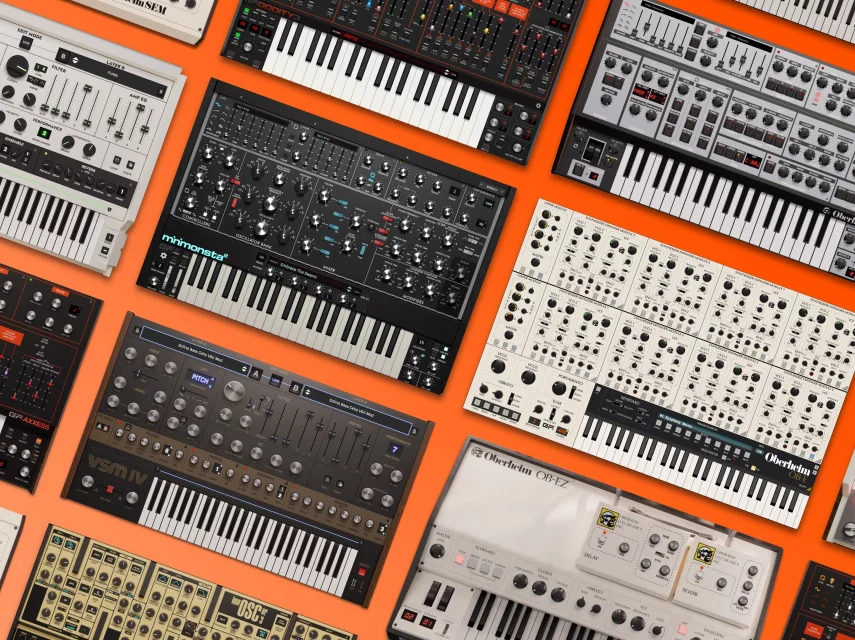November 13, 2025
by GForce Software
Items marked with ** are sold separately and not included in any bundle.
| Product | M-Tron Pro Complete | Oberheim – The Bundle | Analogue Series Bundle V2 | Ultimate Bundle V2 |
| [New] GForce MAP | – | – | – | New ✔ |
| [New] Halogen FM | – | – | – | New ✔ |
| [New] Oberheim TVS Pro | – | ✔ | New ✔ | New ✔ |
| [New] Novation Bass Station | – | – | New ✔ | New ✔ |
| [New] IconDrum | – | – | New ✔ | New ✔ |
| VSM IV | – | – | – | ✔ |
| MkII | – | – | – | ✔ |
| impOSCar3 | – | – | ✔ | ✔ |
| Minimonsta2 | – | – | ✔ | ✔ |
| Oddity3 | – | – | ✔ | ✔ |
| OB-X | – | ✔ | ✔ | ✔ |
| OB-1 | – | ✔ | ✔ | ✔ |
| OB-E | – | ✔ | ✔ | ✔ |
| SEM | – | ✔ | ✔ | ✔ |
| OB-EZ | – | ✔ | ✔ | ✔ |
| DMX | – | ✔ | ✔ | ✔ |
| Axxess | – | – | ✔ | ✔ |
| M-Tron Pro IV | ✔ | – | – | ✔ |
| Axxess – Electronica expansion pack | – | – | – | ✔ |
| Axxess – Pop expansion pack | – | – | – | ✔ |
| Axxess – Hip hop expansion pack | – | – | – | ✔ |
| Axxess – Cinematic expansion pack | – | – | – | ✔ |
| Minimonsta2 – 90s inspiration expansion pack | – | – | – | ✔ |
| Dust-O-Tron for M-Tron Pro | ✔ | – | – | ✔ |
| Alex Ball for M-Tron Pro | ✔ | – | – | ✔ |
| Hainbach for M-Tron Pro | ✔ | – | – | ✔ |
| The Streetly Tapes Vol 1 for M-Tron Pro | ✔ | – | – | ✔ |
| The Streetly Tapes Vol 2 for M-Tron Pro | ✔ | – | – | ✔ |
| The Streetly Tapes Vol 3 for M-Tron Pro | ✔ | – | – | ✔ |
| The Streetly Tapes Vol 4 for M-Tron Pro | ✔ | – | – | ✔ |
| The Streetly Tapes Vol 5 for M-Tron Pro | ✔ | – | – | ✔ |
| The Streetly Tapes Vol 6 for M-Tron Pro | ✔ | – | – | ✔ |
| The Streetly Tapes Violins & Vox for M-Tron Pro | ✔ | – | – | ✔ |
| The Streetly Tapes SFX Console for M-Tron Pro | ✔ | – | – | ✔ |
| The Streetly Tapes M300 for M-Tron Pro | ✔ | – | – | ✔ |
| Orchestron for M-Tron Pro | ✔ | – | – | ✔ |
| Optitron for M-Tron Pro | ✔ | – | – | ✔ |
| Chambertron for M-Tron Pro | ✔ | – | – | ✔ |
| M-Tron Pro IV – Lament by Venus Theory | ✔ | – | – | New ✔ |
| Minimonsta2 – Analog Synth Pop by Plughugger | – | – | – | New ✔ |
| Minimonsta2 – Coalescence by Sandunes | – | – | – | New ✔ |
| Minimonsta2 – Modern Pop by K/V | – | – | – | New ✔ |
| OB-E – 70’s Studio by Polydata | – | – | – | New ✔ |
| OB-X – Airwaves by Reverb Machine | – | – | – | New ✔ |
| OB-X – Classic Synth Pop by K/V | – | – | – | New ✔ |
| OB-X Dark Edge by Danny Nugent | – | – | – | New ✔ |
| Oddity3 – Dark Cinematic by K/V | – | – | – | New ✔ |
| Oddity3 – Electronica Studio by GEOSynths | – | – | – | New ✔ |
| Oddity3 – Session Synthesist bt Polydata | – | – | – | New ✔ |
| SEM – 80s Cinematic Sequences by K/V | – | – | – | New ✔ |
| SEM – Analog Studio ’74 by Polydata | – | – | – | New ✔ |
| SEM – asSEMbly by Jordan Passmore | – | – | – | New ✔ |
| Axxess – Vestra by Jordan Passmore | – | – | – | New ✔ |
| impOSCar3 – Cinecore by Zardonic | – | – | – | New ✔ |
| [New] Novation Bass Station – Dominion by Zardonic** | – | – | – | – |
